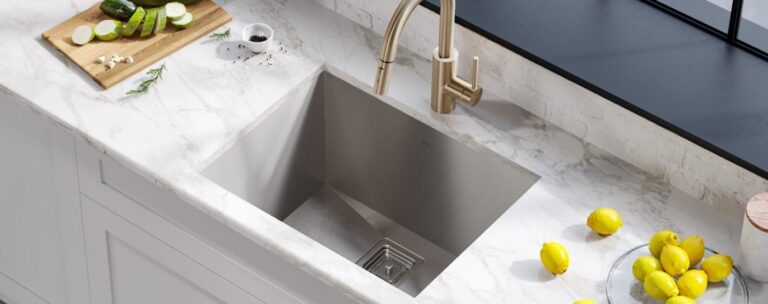The ubiquitous use of undermount sinks in kitchens may have led you to a thought of investing in one such model for your home too. These sinks fit beneath the countertops with the help of adhesive, brackets, and clips. Since the whole basin hangs from the underside of the worktop, you have to make sure its installation is correct. For that, you would need professional support. Experts recommend that you should choose this style only if your countertop consists of dense material. Laminated or tiled worktops may not bear its weight and crackdown over a period. Therefore, you have to be pretty thoughtful about how you go about this choice.
Since these sinks tend to be comparatively expensive than their top mount counterparts in terms of product and installation cost, it can act as a barrier in your decision-making. Plus, many undermount models come without faucet ledge, due to which you may have to pay additionally for installing faucets and accompanying materials. Consequently, all of this can further increase your expenses. So, it would help if you know how much you can afford and whether that would be sufficient for this kitchen sink style or not. If it doesn’t look like a problem, then you can opt for an undermount kitchen sink tension-free.
To enjoy this modern yet timeless feature in your cooking space, you would need to consider a few factors. Let’s dig into them for a quick insight.
Points to consider when buying an undermount sink
Countertop material
As hinted above, one of the most critical things that you need to consider is your countertop material before you buy an undermount model in the kitchen sink. If the worktop surface is solid, then only you should choose an undermount style. Concrete, stainless steel, natural stone, granite, and composites can be some of the perfect companions for this sink. Then, if you pick a larger variation, make sure to add additional framework while installing it. For instance, a 40-inch wide (16 gauge) stainless steel bowl may perform well with wooden support. So, ensure that there is adequate support for the sink that will sit underneath the cabinet.
Kitchen sink material
A large number of US homes have stainless-steel undermount sinks in their kitchens. They get inspired either from interior décor magazines and blogs or the assumed durability of this material. Other than that, you also get excellent choices in stone sinks. If you want to increase the aesthetics of your modern kitchen, then investing your money in stone can be a good idea. Don’t worry about the cost. You can work around it and save a few bucks too. However, if you crave variety, then stainless steel is probably the right area where you should focus. It is a durable material compared to ceramic and stone. Also, it can recover all your expenses over a due course of time.
Sink reveal
It may not be a well-known element, but it does play a critical role in the installation process. Hence, as a homeowner, you need to be aware of this factor. At the time of fabrication, professionals account for the overall size of the sink so that there is enough countertop material left around it. Otherwise, they can risk the thinnest surface. So, it makes sense to think about the sink reveal. “Reveal” indicates how much of the undermount sink should remain exposed under the counter. Usually, there are three ways of doing it.
- Flush-mount: In this, the countertop and the basin enjoy a seamless design with no bumps and breaks in between them.
- Positive reveal: Some portion of the sink rim gets exposure in this design because countertop rim remains a bit inside.
- Negative reveal: The countertop edge covers the sink rim from all the corners.
All these options have some pros and cons. For example, positive reveal can be easy to achieve, but you need to clean it every day to avoid bacterial growth. Negative reveal is famous for clean lines and easy cleaning. However, it can easily chip and can have mold growth under the rim. Flush mount or zero reveal mounting option is best in terms of cleaning. But it requires precision and skillful handling at the time of installation. Plus, it can incur extra costs. So, when you make a decision, keep these elements in mind too.
Single VS double bowl
You can find it to be an easy choice, but before you pick anything, make sure you know your kitchen habits. Those who have been using dual sink bowls for long wouldn’t need to reconsider their choice until extremely necessary. But if you are new to this option, then it’s better to assess your needs first. Single bowl sinks tend to be spacious. You can wash large pans and pots hassle-free in them.
In double basin models, you usually get two equal sizes of the bowl or in the 60/40 ratio. The measurements may vary, though. Anyway, if you are a multitasking person, who preps food and rinse dishes at the same time, then a double bowl system can work well for you. But if you are a busy cook who uses large utensils, then single sinks can be the right alternative.
There are many varieties in undermount sinks that you witness in the market. Each may have its upside and downside. You need to make up your mind as to why you would select something over the other and how you can use it the best way. The investment cost is going to be significant here. But if you spend wisely, there is nothing to worry about as such.
Also, visit only reputed stores for purchasing one for your kitchen. Trustworthy brands don’t take a risk with their name and status. Hence, you can expect the quality of their product to remain intact even after multiple and heavy uses. Don’t think that undermount models can go out of fashion ever. The comfort and elegance of these variants will always keep them in trend.




